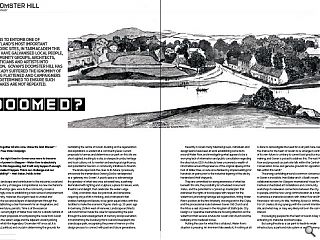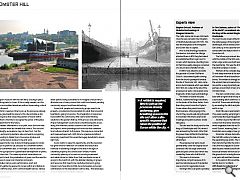Doomster Hill
18 Jul 2012
Plans to entomb one of Scotland's most important historic sites in tarmacadem this July have galvanised local people, community groups, architects, politicians and artists into action. Here photographer Tom Manley explains why although Govan's Doomster Hill may have already been flattened campaigners are determined to ensure such mistakes are not repeated.
“This is the right time for Govan once more to become a place of power in Glasgow – Water Row is absolutely central to this happening, but it will only happen if enough people make it happen. This is our challenge and our responsibility!” – Matt Baker, Public Artist
Govan’s landscape and contribution to the industrial, social and maritime story of Glasgow is inspirational. As new mechanisms and partnerships give voice to the community, Govan is tantalizingly close to establishing a new sense of empowerment and identity. However, the urgent need to unravel and identify the successive layers of development through the eras, establishing a clear framework for an imaginative, and innovative future, persists. Time is of the essence!
The current plight of Water Row calls for a drastic rethink of development proposals. Encompassing the route from Govan Cross to the water’s edge and the adjacent vacant parking land on which the legendary ‘Doomster Hill’ once sat, it is powerful, political, and crucial in determining the grounds for revitalizing the centre of Govan, building on the regeneration and aspirations so evident at a community level. Current proposals to tarmac and determine a car park on this site are short sighted; insulting to a site, so steeped in pride, heritage and local culture, not to mention archaeological significance, and potential for tourism or community initiatives to flourish.
The landscape holds the clues to its future. I previously envisioned the tremendous Graving Docks reinterpreted as a ‘gateway into Govan’: A public space to acknowledge the grandeur of what was once achieved here, a parkway illuminated with lighting and sculpture; a place for leisure, work, theatrics and delight, that celebrates the waters edge.
Okay, a romantic idea, but practical, and achievable requiring only a shift in thinking, and a framework that enables heritage and leisure, to be given equal status with the facilities to make the economic figures stack up. 20 years ago In Germany, 250km west of Hanover, Landscape architects Latz and Partner made the case for representing the past, through the acknowledgement of memory and preservation in transforming the Dusiburg-Nord coal and steel plant into a landscape park, recognizing the power of memory in the design process to connect with past and future generations.
Recently in Govan many talented groups, individuals and design teams have been at work establishing some facts around Water Row, and investigating what appears to be a worrying lack of information and public consultation regarding the sites future. EDO Architects have uncovered a wealth of information around the presence of the original slipway at the foot of Water Row, a route once flanked by simple buildings for hundreds of years prior to the industrial layering of the site by Harland and Wolf shipyards.
They are committed to raising awareness of what lies beneath this site, the possibility for scheduled monument status, and the potential for a ‘joined up masterplan’ that addresses the rights of local people with respect for the waterfront, promoting heritage led regeneration, fitting Water Row’s position as the first Westerly crossing point in the Clyde, and the processional route between Govan Old Church and the hill as a seat of power in the Kingdom of Stathclyde. City Design Co-operative meanwhile are focusing attention on the waterfront that secures a future for Govan Old Church and the redisplay of its medieval stones.
Putting the case for what this is all about, Water Row’s situation is pressing. An imminent fate awaits it, if nothing at all is done to reinvestigate the need for a car park here. Denying the chance for the heart of Govan to re-emerge in control of its own future is contrary to current best practice in place making, and Govan is poised to address this. The vast Water Row and proposed car park site falls within the Central Govan Conservation Zone, and genuine grounds for opposition surely falls within this remit?
The energy unfolding around a common consensus in Govan is incredible. Matt Baker and t s Beall’s recent collaborative event for Glasgow International Visual Art Festival orchestrated art installations and community workshops to reawaken connections between the city, its people, and the river, using communication as a metaphor to embrace a shared association with Water Row and the Riverside’s rich story. Its title, ‘Nothing About Us Without Us Is For Us’ creates strong synergy with the current intention for the site, and what may or may very likely not be in the community’s interest.
Encouraging people into the heart of Govan is key to enlivening its character and townscape. But using the site as a car park to feed into wider infrastructure, a park and ride system or even as overspill for the transport museum with the new ferry crossing in place gives nothing back to Govan. If this is really needed, can this not be accommodated elsewhere without desecrating a site of such significance?
A rethink is required, time to join up the processes already underway, give breathing space to this site and allow a site-specific response that raises the position of Govan within the city. Now is the time to recognize the power of the place and interpret that for the future.
Any realistic alternative to a car park, must do more than purely preserve what lies beneath the surface. The cost and time for lengthy excavations may not bear fruit - but the heritage and tourist potential is alive and well in recognizing and responding to Water Row’s true sense of place and enhancing the area as a place to live and work.
The opportunity now is about bringing people to Govan, but not just to park the car, because it is convenient before leaving for somewhere else, or we might as well lie down and accept every proposal for questionable development on prime, vacant urban sites. This raises important issues about our attachment to land, the privatization of space, and the need for public space to save local character and assets.
The Gallus Games, puts performance, sport and community gathering space into Govan within an initiative to coincide with the city’s 2014 Commonwealth Games. Various sites are being explored for this temporary structure, but with other options being considered to re-imagine a future here, it illustrates one of many visions that could be achieved, pending community support and financial backing.
Govan folk, people and community groups need to be properly consulted and incorporated into what their ancestral heartland is going to become. The imagination of responses found within the community offer real forward thinking solutions to the powers that be, if this process was adhered to. Proper management could unlock unrestricted public access along the riverfront, attract tourism to the Govan Stones and beyond, whilst providing local resources that celebrate local cultures inherent to this place. This requires a connected and measured approach. With time to organize and attract necessary investment this would be hugely beneficial to Govan right now.
Govan wants to seize this opportunity, and the recession has given time for reflection on resilient and resourceful methods of delivering change for the area in the light of a flatlined property and construction climate. Positive community planning is focused on securing a reasoned and viable future for Water Row, that coordinates issues of access to the riverfront, with the delicate interplay of groups and resources that need to be carefully entwined in going forward. Lets have time to think here and explore some real contributions to this site before it’s all too late… This landscape is rich, it deserves more than a carpark.
Experts View
Stephen Driscoll, Professor of Historical Archaeology at Glasgow University
The Celtic stones (at Govan Old Parish Church) were carved in the Kingdom of Strathclyde between 870-1170. This was the final phase of the Kingdom and Govan was its capital.
Prior to that the kings resided in Dumbarton, but when the Vikings attacked there in 870 they fled inland and established their royal court in Govan, which became a bustling town.At that time nearby Glasgow consisted of a church and a handful of huts.
In 1994 I was asked to excavate the grounds of Govan Old Parish Church. I discovered a path running from the church graveyard towards the site of Doomster Hill. I also came across burnt material which was dated 800-900 AD. Later, at the site of the proposed car park, I discovered some fragments of late medi-eval buildings.
The Parish of Govan includes Partick. I believe the kings lived there, on the banks of the River Kelvin. From there they would cross the Clyde to Govan where they would conduct their business. After praying in the church they would walk along the path to Doomster Hill where ceremonial meetings and public business would take place.
This site was the focal point for the kings of Strathclyde until 1114, when it was annexed by the Scots. After that the power base shifted to the Bishops of Glasgow and the role of Govan diminished.
The proposed car park would permanently cover the original site of Doomster Hill, the royal ceremonial path and parts of the ditch which was created by those who built the hill.
This area is of immense importance, not just because of its past, but also because of its potential use as a tool to regenerate Govan.
Turning it into a car park is possibly the worst option.
Dr Tim Clarkson, author of “The Men of the North”, an academic study of the kings of the ancient kingdom of Strathclyde.
The word Govan means little hill in the old language of the kingdom of Strathclyde, which existed until the 12th century. In this case the town was named after the feature which was Doomster Hill.
The hill was a prominent landmark until the middle of the 19th century, when a dye works was built nearby by the Reid family. This was the first major industrial complex in Govan.
Workers at the complex dug a 12-foot deep reservoir at the summit of Doomster Hill and found human bones. The evidence strongly suggests the workers had uncovered a burial mound for a very important person, perhaps a local chief or hero of pre-Christian times.
The site’s construction, a big flat base with a higher level on top and a surrounding ditch confirms it as a moot hill. These were artificially built by excavating the ditch and piling the earth on top.
Moot hills were ceremonial hills. They were used by early kings for ceremonies like royal inaugurations. Another clue to the hill’s history comes from the name ‘Doomster’, which originates from the old Scots word ‘Dooms’, meaning ‘laws’. A Doomster was a judge or law-giver.
Doomster Hill was demolished in the mid 19th century to make way for the expanding dye works. The site was then transformed into the Old Govan Yard, the first shipyard in Govan which later became Harland and Wolff. Any historical remains will now be under the ground and covering the area with a car park will seal them forever.
In my opinion this would be a terrible loss for Scotland.
With thanks to Colin Grant of Spectrum PR for conducting both interviews.
Read next: Fore Street
Read previous: Top Landscape Architects
Back to July 2012
Browse Features Archive
Search
News
For more news from the industry visit our News section.
Features & Reports
For more information from the industry visit our Features & Reports section.




